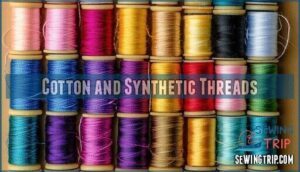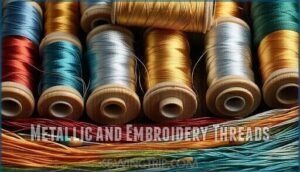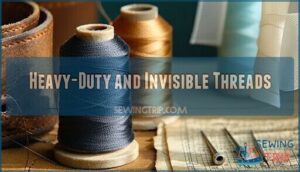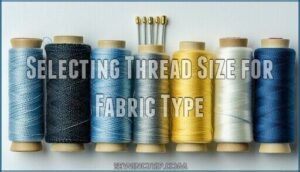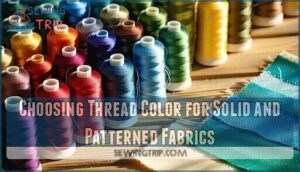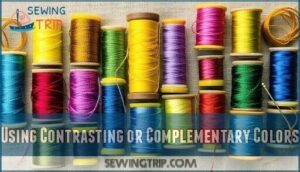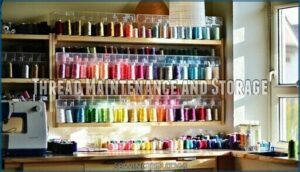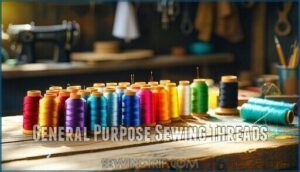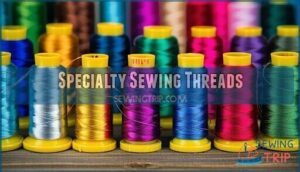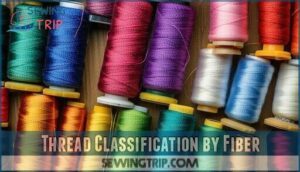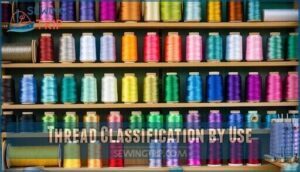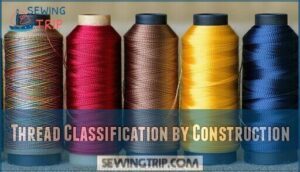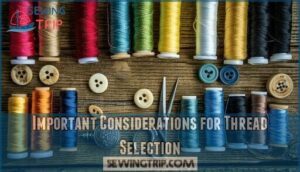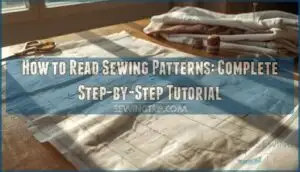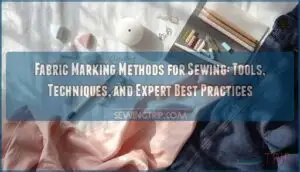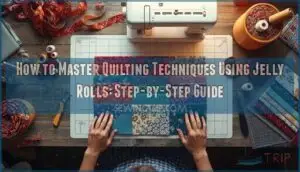This site is supported by our readers. We may earn a commission, at no cost to you, if you purchase through links.
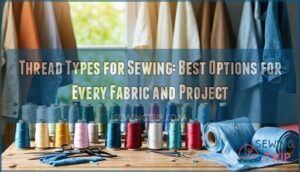
Cotton thread pairs beautifully with natural materials like linen or quilting cotton, while silk thread is ideal for delicate fabrics.
For heavy-duty projects like denim or upholstery, go with a strong, thick thread. Want to get fancy? Metallic and embroidery threads add decorative flair.
Always match thread weight and fiber to your fabric for the best results. Ready to level up? There’s a whole world of specialty threads waiting for you.
Table Of Contents
- Key Takeaways
- Choosing The Right Thread Type
- Thread Types and Properties
- Thread Size and Color Selection
- Thread Maintenance and Storage
- General Purpose Sewing Threads
- Specialty Sewing Threads
- Thread Classification by Fiber
- Thread Classification by Use
- Thread Classification by Construction
- Important Considerations for Thread Selection
- Frequently Asked Questions (FAQs)
- Conclusion
Key Takeaways
- Match thread to fabric weight – You’ll get the best results by using lightweight threads (60-80) for delicate fabrics like silk, standard threads (50-60) for cotton blends, and heavyweight threads (30-40) for denim or canvas.
- Choose the right fiber for your project – Cotton thread works beautifully with natural fabrics and breathes well, while polyester thread offers superior strength and flexibility for synthetic materials and high-stress seams.
- Consider your project’s specific needs – You’ll want specialty threads like heavy-duty for upholstery, invisible thread for seamless repairs, metallic for decorative work, and embroidery thread for detailed stitching.
- Invest in quality thread and proper storage – You’ll prevent breakage and achieve professional results by choosing reputable brands like Gutermann or Coats & Clark, and storing your threads in cool, dry places away from sunlight to maintain their strength and color.
Choosing The Right Thread Type
Choosing the right thread type guarantees your stitches are strong, neat, and suited to your fabric.
You’ll need to evaluate the fabric’s weight, thread fiber, and size to get the best results.
Matching Thread With Fabric Weight
How do you guarantee your sewing project holds together perfectly?
Match the sewing thread type to your fabric’s weight for flawless results. The wrong thread thickness can ruin your work, so follow these tips:
- Lightweight fabrics: Use lightweight threads (sizes 60-80) for delicate materials like chiffon or silk.
- Medium-weight fabrics: Choose standard threads (sizes 50-60) for cotton or blended fabrics.
- Heavyweight fabrics: Opt for heavyweight threads (sizes 30-40) to handle denim or canvas.
Pairing the right thread weight with your fabric guarantees strong, even stitches.
Considerations for Thread Fiber Content
When picking sewing thread types, consider fiber performance.
Natural vs. synthetic matters: cotton thread suits breathable fabrics, while polyester thread offers strength and versatility.
Silk adds elegance to delicate projects, and nylon thread excels in heavy-duty tasks.
Thread blends balance durability and flexibility.
Also, think about dye absorption and environmental impact to match thread types perfectly with your fabric needs.
Thread Size for Different Fabrics
Thread size isn’t just about looks—it’s about seam strength and thread compatibility with fabric types.
Matching thread weights to fabric weight guarantees your project holds together beautifully.
Here’s a quick guide:
- Light fabrics like cotton need fine threads (60-90) for smooth seams.
- Heavy fabrics like denim require thicker threads (30-40) for durability.
Pair needle size with thread thickness to avoid snags.
Thicker threads suit dense fabrics, boosting seam strength.
Precise thread size prevents tension issues and uneven stitching.
Get this right, and your seams will stand the test of time!
Thread Types and Properties
Understanding thread types and their properties helps you match the right thread to your fabric and project needs.
From cotton to metallic options, each thread offers unique strengths, making it essential to choose wisely.
Cotton and Synthetic Threads
Choosing between cotton and synthetic threads depends on your project’s needs.
Cotton thread works beautifully with natural fabrics, offering softness and breathability.
However, it has moderate strength and limited flexibility, making it better suited for lighter, non-stretch garments.
Polyester thread, on the other hand, shines with its strength, flexibility, and resistance to shrinkage, making it a go-to for synthetic fibers and high-performance fabrics.
Blended options combine the best of both worlds, balancing strength and compatibility for mixed fabrics.
Keep in mind, synthetic fibers like nylon thread are ideal for heavy-duty tasks due to their elasticity and durability.
Always consider factors like fiber blends, thread finishes, dye absorption, and environmental impact when choosing sewing thread types for your projects.
Metallic and Embroidery Threads
Metallic and embroidery threads often bring a touch of magic to your projects.
Their vibrant colors and metallic thread sparkle can elevate even the simplest designs.
To master these threads:
- Use specialty needles to prevent fraying and guarantee smooth stitching.
- Adjust tension for embroidery stabilization and better thread compatibility.
- Pair metallic fibers with rayon thread embroidery for stunning decorative effects.
Whether you’re using an embroidery machine thread or hand-stitching, metallic durability guarantees your designs shine bright and last beautifully.
You can find a variety of options for metallic thread products.
Heavy-Duty and Invisible Threads
When tackling tough fabrics like leather, denim, or canvas, heavy-duty thread is your go-to. It’s strong, abrasion-resistant, and perfect for upholstery, outdoor projects, or durable jeans stitching.
Invisible thread, made from nylon or polyester, is ideal for delicate repairs or creating seamless finishes on multicolored fabrics.
- Use specialty needles for heavy-duty or invisible thread clear applications
- Adjust thread tension to avoid puckering or snapping
- Match upholstery thread durable properties to fabric weight for maximum results
- Explore heavy duty thread versatility in denim projects and beyond
Mastering these threads guarantees professional-quality stitching with strength and subtlety for every sewing challenge, using the right thread for the job, such as heavy-duty thread or invisible thread.
Thread Size and Color Selection
Choosing the right thread size and color can make or break your sewing project.
You’ll want to match the thread’s thickness to your fabric and pick a color that blends seamlessly or adds the perfect contrast.
Selecting Thread Size for Fabric Type
| Fabric Weight | Thread Size | Needle Size |
|---|---|---|
| Lightweight | 60-90 | 60/8-80/12 |
| Medium | 30-50 | 80/12-90/14 |
| Heavy | 20-30 | 90/14-100/16 |
Matching thread thickness to fabric weight guarantees smooth stitching and strong seams.
Lightweight fabrics need finer threads, while heavier materials require thicker ones.
Pair the right needle size to prevent skipped stitches or fabric damage.
Test stitch density and thread tension on scraps first—this saves headaches later.
With proper thread types and needle size, your project will hold up beautifully.
Choosing Thread Color for Solid and Patterned Fabrics
Picking the right thread color makes your project shine. For solid fabric matching, aim for a seamless look by following these steps:
- Match the thread color to the fabric as closely as possible.
- Choose a slightly darker shade for added depth and richness.
- Test thread color under different lighting to check for tonal shades.
- Use natural daylight for the truest fabric matching results.
These tips guarantee polished, professional sewing every time!
Using Contrasting or Complementary Colors
Think of your thread as a painter’s brush—it can add bold statements or subtle accents to your project.
Using Color Wheel Basics, try Contrast Stitching with complementary shades for colorful surprises, or experiment with tonal shades for Complementary Blending.
Always test on fabric scraps to avoid mismatched results.
Whether you’re enhancing sewing thread types or exploring new thread types, these small tweaks transform ordinary sewing into art.
Let your thread choices spark creativity and elevate your designs!
Thread Maintenance and Storage
Proper thread maintenance and storage keep your spools in great condition and ready for use. Store them in a cool, dry place to prevent damage from moisture, sunlight, or dust.
Preventing Thread Disintegration and Breakage
Keeping your threads in top shape is like giving your sewing projects a solid backbone. Poor storage can lead to thread breakage and weaken thread strength.
Follow these steps for better thread quality:
- Store threads in cool, dry spaces, avoiding sunlight that can damage fiber types.
- Use sealed containers to protect against dust and moisture, ensuring thread weights stay consistent.
- Check thread storage regularly, rotating older spools to prevent degradation.
- Match thread quality with proper needle size and machine tension for smooth stitching every time, which is crucial for maintaining thread strength.
Reviving Dry and Brittle Thread
Humidity effects can leave sewing thread types brittle and prone to breakage, but simple thread conditioning tricks can bring them back to life.
Try placing your thread in a resealable bag with a damp paper towel, then refrigerate overnight. For stubborn dryness, massage beeswax or a dab of silicone oil onto the thread to restore flexibility.
Always test the thread’s strength by gently pulling it before sewing.
Proper thread storage, like using airtight containers or adding silica gel packets, prevents future moisture loss and keeps your thread project-ready.
Choosing Reputable Thread Brands
After restoring brittle thread, it’s smart to focus on reputable brands that guarantee quality.
Trusted names like Gutermann, Coats & Clark, and Mettler stand out for their fiber quality and thread consistency. Don’t settle for the cheapest option—investing in reliable sewing thread types saves time and frustration.
Here’s what to look for:
- Brand reputation backed by user reviews.
- Consistent dye adherence for vibrant results.
- Wide brand availability online and in stores.
- Threads suited for various project needs.
Choose wisely and stitch smoothly!
General Purpose Sewing Threads
You’ll find general purpose sewing threads perfect for most fabrics and everyday projects. They’re durable, versatile, and usually made of polyester or a polyester-cotton blend.
Polyester and Cotton Threads
Polyester and cotton threads are staples among sewing thread types, each with unique strengths.
Polyester thread boasts excellent durability and stretch resistance, making it ideal for heavy-duty projects or synthetic fabrics.
Cotton thread, with its natural fiber properties, provides softness and breathability, perfect for lightweight or delicate materials.
Blends combine the advantages of both, offering versatility. For eco-conscious crafters, cotton’s environmental impact is lower.
You can find various polyester options online. Match thread to fabric for flawless results, considering the environmental impact.
All-Purpose Thread for Versatile Use
An all-purpose thread is your sewing toolbox’s MVP.
Typically made from polyester or a polyester-cotton blend, it offers versatility for various sewing thread types.
Whether you’re stitching lightweight cotton fabrics or heavier materials, its balanced strength and flexibility handle most projects with ease.
Prioritize thread weight and color matching for polished results.
Trusted brands like Gutermann and Coats & Clark guarantee consistent quality.
Store spools away from sunlight to keep this general-purpose thread ready for any task.
Specialty Threads for Specific Projects
When your sewing projects require precision, specialty thread types step in to elevate your work.
Elastic thread is perfect for shirring or gathered effects, while metallic thread adds sparkle to decorative stitching.
For heavy-duty tasks like cushions or bags, upholstery thread offers durability.
Invisible thread works wonders for low-profile repairs, and quilting thread guarantees your fabric layers stay secure.
Whether it’s embroidery or quilting, these threads bring versatility and flair to every stitch.
Specialty Sewing Threads
Specialty sewing threads are designed to handle unique fabrics and specific tasks that standard threads can’t manage.
From embroidery to upholstery, these threads offer strength, flexibility, or decorative flair to suit your project needs, providing a solution with unique properties for various applications.
Embroidery and Quilting Threads
In regards to adding flair and precision to your projects, embroidery and quilting threads are essential tools.
These specialty thread types offer unique properties that elevate your work, whether you’re embellishing fabric or piecing together a quilt.
- Thread Weight Matters: Choose 40 wt for dense embroidery and 50-60 wt for fine quilting details.
- Fiber Content Counts: Rayon embroidery thread adds sheen, while cotton quilting thread offers durability.
- Color Fastness Is Key: For vibrant, lasting designs, opt for trusted brands like Madeira or Gutermann.
- Needle Compatibility: Pair your thread with the right needle size to avoid snags or breakage.
Explore options to purchase quality threads for your next project.
Always test your thread on scrap fabric to check stitch density and tension.
A little prep guarantees flawless results!
Upholstery and Metallic Threads
For heavyweight upholstery, durability is key.
Upholstery thread, often a polyester-cotton blend, resists abrasion and handles wear from everyday use.
If you’re aiming for elegance, metallic threads add decorative stitching flair with their shimmer.
These thread types require careful needle selection—using the correct thread gauge guarantees project suitability and a professional finish.
Whether it’s heavy-duty upholstery or metallic durability, matching thread to fabric guarantees your furniture pieces shine and stand up to the test.
Elastic and Invisible Threads
Elastic and invisible threads are perfect for creative projects that demand flexibility or subtlety.
Elastic thread shines in stretch fabric sewing, offering elasticity for shirring waistlines or chest areas. Invisible thread, available in clear monofilament or multifilament types, guarantees seamless finishes for quilting or embellishments.
- Elastic Shirring: Add stretch and gather to garments effortlessly.
- Invisible Thread Color: Choose clear options for low-profile repairs.
- Tension Tips: Adjust machine settings to avoid thread snapping.
- Professional Finishes: Use monofilament thread for invisible seams or decorative stitching.
These sewing thread types elevate designs with precision and adaptability.
Thread Classification by Fiber
When choosing thread, its fiber content plays a key role in matching it to your fabric and project needs.
Understanding the differences between natural and synthetic fibers guarantees better results and durability.
Cotton Thread for Natural Fabrics
Cotton thread is your go-to for projects with natural fibers, offering versatility and reliability.
Whether you’re tackling machine quilting, tie-dye projects, or crafting loose-fitting garments, cotton thread sewing delivers smooth, durable results.
Its breathable nature pairs perfectly with fabrics like linen, muslin, and lightweight cotton, ensuring stitches that last without compromising comfort.
For heirloom quilting or special garment types, 100% mercerized cotton threads stand out.
They bring enhanced strength and a silk-like sheen, elevating your work’s overall quality.
Want to keep things eco-friendly? Opt for GOTS-certified organic cotton threads from trusted brands like Gutermann.
Store your thread in a cool, dry place, away from sunlight, to maintain its durability.
With cotton, you’re working with one of the most dependable sewing thread types.
Polyester Thread for Synthetic Fabrics
Polyester thread is your go-to for synthetic materials like nylon, spandex, or blends.
Known for its durability and synthetic compatibility, it handles wear and tear effortlessly. Its slight stretch boosts seam strength, reducing breakage during movement.
Plus, its colorfastness guarantees vibrant stitches that last. With various thread finishes, it works well for activewear, upholstery, or decorative stitching.
Trust brands like Gutermann for consistent results, making polyester thread a reliable choice across sewing thread types.
Silk and Wool Threads for Specialty Projects
Silk and wool threads bring elegance and versatility to specialty projects, especially when working with delicate fabrics or textured designs.
Silk thread glides effortlessly, making it perfect for couture garments and invisible seams. Wool thread shines in hand needlework, adding warmth and charm to embroidery or knitting projects.
Both threads elevate your creations with natural beauty and durability.
- Silk thread uses: Ideal for embroidery and sewing fine fabrics.
- Wool thread uses: Great for knitting and textured designs.
- Adds sculptural texture to textile art.
- Perfect for hand needlework.
- Enhances delicate fabrics beautifully.
Thread Classification by Use
Thread classification by use helps you match the right thread to your project’s specific needs.
From serger threads to decorative ribbon floss, understanding their applications guarantees strong seams and polished finishes.
Serger and Machine Embroidery Threads
Specialized sewing machines demand their own thread families. Serger thread types like lightweight polyester create clean, professional overlock seams without bulk.
For machine embroidery thread, focus on embroidery thread weight—finer threads produce crisp, detailed designs. Thread tension tips are essential: adjust settings to prevent breaks or puckering.
Design considerations matter too—dense patterns need stronger threads. Quality serger and embroidery thread types paired with proper stabilizers usage transform ordinary projects into polished masterpieces.
Choose reputable brands for consistent results across all your machine embroidery thread and serger thread overlock projects.
Lingerie and Washaway Threads
Three specialized thread types transform your lingerie sewing experience.
Washaway thread dissolves completely in cold water, making it perfect for temporary basting and testing new patterns on delicate fabrics.
Elastic thread creates stretchy seams that move with your body, essential for comfortable lingerie construction.
Invisible thread provides nearly seamless finishes on sheer fabrics.
These lingerie thread types require gentle handling and proper storage to maintain their unique properties for professional-quality delicate fabric seams.
Ribbon Floss for Decorative Projects
Moving beyond lingerie work, ribbon floss opens up exciting possibilities for decorative stitching and embellishments.
These floss material options feature wider, flatter construction than standard thread types, creating stunning texture and dimension in your sewing projects.
You’ll find color palette ideas ranging from subtle pastels to vibrant metallics.
Master ribbon stitch techniques like lazy daisy and French knots for dramatic effects.
Perfect for project showcase pieces, ribbon floss transforms plain fabrics into eye-catching masterpieces through creative decorative stitching applications.
Thread Classification by Construction
You’ll find that thread construction affects how your thread performs during sewing and how your finished project looks.
Understanding whether you’re working with spun, corespun, monofilament, or bonded threads helps you choose the right option for your fabric weight and project requirements.
Spun and Corespun Threads
Understanding how threads are built affects your project’s success more than you might expect.
Spun thread creates strength by twisting short fibers together, while corespun thread wraps those same fibers around a polyester or nylon core for added durability.
Spun Properties make these threads perfect for everyday sewing.
Cotton thread works beautifully with natural fabrics, offering breathability and a classic feel.
Polyester thread brings modern reliability to synthetic materials.
Corespun Durability shines when you need Thread Strength that won’t quit.
These thread types combine Blending Fibers technology with practical performance.
Consider these factors when choosing between spun and corespun thread:
- Spun thread costs less but offers solid performance for basic projects
- Corespun thread provides superior strength for heavy-duty sewing
- Cotton variations work best with natural fabric weights
- Polyester options handle synthetic materials with ease
- Cost Comparison favors spun for budget-conscious sewers
Monofilament and Bonded Threads
Beyond spun constructions, monofilament and bonded threads offer specialized solutions for demanding projects.
Monofilament thread consists of a single continuous fiber, creating invisible seams perfect for hemming and quilting. This transparent thread blends seamlessly with any fabric, though it can feel stiff due to its uniform structure.
Bonded thread features a protective coating that prevents fraying and withstands thread abrasion during high-speed sewing. The bonded strength makes it ideal for upholstery and canvas work where durability matters most. Different coating types enhance performance—nylon bonding provides chemical resistance while polyester coatings offer heat tolerance.
These thread types excel in special applications where standard threads fail, delivering professional results when you need invisible stitching or maximum strength.
Understanding Thread Construction for Project Needs
Thread construction shapes every stitch you make. When selecting sewing thread, consider how Thread Ply and Fiber Twist affect thread strength and durability. Core Materials determine flexibility, while Thread Finishes impact smoothness through your machine. Bonded Threads offer extra security for heavy-duty projects.
Your thread selection depends on three key factors:
- Thread weights – Match lighter threads to delicate fabrics, heavier ones to sturdy materials
- Project stress – High-wear items need stronger thread durability
- Fabric compatibility – Consider how thread construction interacts with your chosen material
Understanding these elements guarantees professional results every time.
Important Considerations for Thread Selection
When choosing thread for your sewing project, you need to match thread quality with your fabric weight and project requirements.
The right thread selection prevents tension issues, broken seams, and guarantees your finished project looks professional and lasts longer, which is a key factor in ensuring the project’s overall quality.
Thread Quality and Consistency
Quality separates professional results from amateur disasters.
Brand reputation matters because established manufacturers maintain strict fiber consistency standards.
Superior threads offer reliable thread strength, preventing thread breakage mid-project.
Look for dye fastness that won’t bleed onto your fabric.
Thread smoothness reduces machine tension issues and prevents snagging delicate materials.
Consistent thread fibers create even stitches without splitting or fraying.
Invest in thread quality from trusted brands—your sewing machine and finished projects will thank you for choosing reliability over cheap alternatives.
Thread Weight and Fabric Compatibility
Matching thread weights with fabric creates seamless, professional results.
Your Fabric Weight Guide and Thread Thickness Chart become essential tools for perfect stitching. When thread thickness aligns with fabric density, you avoid puckering and thread breakage.
Here’s your compatibility roadmap:
- Heavy fabrics require thick threads (30-40 weight) with larger needle sizes for durability
- Medium fabrics work best with all-purpose threads (50 weight) and standard needles
- Delicate fabrics need fine threads (60-80 weight) with smaller needles for gentle handling
Proper pairing guarantees consistent Stitch Density Impact across your entire project.
Project Type and Thread Requirements
Every sewing project demands its own thread personality. Garment thread needs vary dramatically—cotton works beautifully for breathable clothing, while polyester handles everyday wear.
Quilting thread type should be sturdy cotton for piecing layers together. Heavy-duty projects require upholstery thread choice that won’t snap under pressure.
Embroidery thread selection focuses on sheen and color vibrancy. Match your thread to your project’s purpose, and you’ll create professional results that last.
| Project Type | Best Thread Choice |
|---|---|
| Everyday Garments | General purpose polyester |
| Quilting Projects | Cotton quilting thread |
| Heavy-Duty Items | Upholstery thread |
| Decorative Work | Embroidery thread |
Frequently Asked Questions (FAQs)
What are the different types of sewing threads?
You might think all threads are the same, but they’re not!
Sewing threads include polyester, cotton, silk, rayon, linen, nylon, and wool.
Each suits specific fabrics, from delicate chiffon to rugged denim.
What thread is best for sewing?
Polyester thread works best for most sewing projects because it’s strong, durable, and flexible.
You’ll find it handles everything from lightweight silks to heavy denim without breaking or stretching out of shape.
Which is thicker, 40 wt or 50 wt thread?
Think of thread weight like rope – the lower the number, the thicker the strand.
You’ll find 40 weight thread is thicker than 50 weight, making it stronger for heavy-duty projects and topstitching work.
What is 70 weight thread used for?
You’ll use 70 weight thread for delicate embroidery, fine quilting, and precision topstitching on lightweight fabrics.
Its ultra-fine diameter creates nearly invisible seams on silk, chiffon, and other delicate materials requiring subtle, refined stitching, making it ideal for projects where precision is key.
What type of thread is best for sewing?
Like choosing the right tool for any job, selecting thread depends on your project’s needs.
For most sewing tasks, you’ll find polyester thread hits the sweet spot—it’s strong, versatile, and works beautifully with various fabrics.
What is the weakest sewing thread?
Cotton thread ranks as the weakest option you’ll encounter.
It splits easily, sheds constantly, and lacks the durability of polyester or nylon.
You’ll find it breaks under stress and requires frequent replacement.
What is thick thread called?
Thick thread goes by several names depending on its purpose.
You’ll find heavy-duty thread, upholstery thread, topstitch thread, and extra-strong thread.
Each serves specific projects requiring durability and strength beyond standard sewing thread, making extra-strong thread a valuable asset.
How do weather conditions affect thread performance?
Before telegraphs revolutionized communication, harsh weather challenged thread performance just as it does today.
You’ll find humidity causes cotton to swell and weaken, while UV rays fade colors and break down synthetic fibers over time.
What thread works best for handcrafted lace?
For handcrafted lace, silk thread is your best bet.
It’s smooth, strong, and blends beautifully with delicate designs.
Use a small needle for precision, and beeswax helps avoid unraveling during intricate stitching.
Can threads be dyed at home safely?
You can safely dye natural threads like cotton, silk, and wool at home using fabric dyes.
Synthetic threads like polyester won’t take dye well.
Follow package instructions carefully for best results, using complete concepts to ensure you achieve the desired outcome.
Conclusion
Mastering thread types for sewing transforms your projects from ordinary to extraordinary.
You’ve learned to match cotton threads with natural fabrics, select polyester for synthetics, and choose specialty threads for specific applications.
Remember to keep in mind thread weight, fiber content, and construction type when making selections.
Quality threads prevent breakage and guarantee consistent results.
Whether you’re hemming a dress, quilting a blanket, or embroidering decorations, the right thread choice makes all the difference in your final project’s success and durability.

